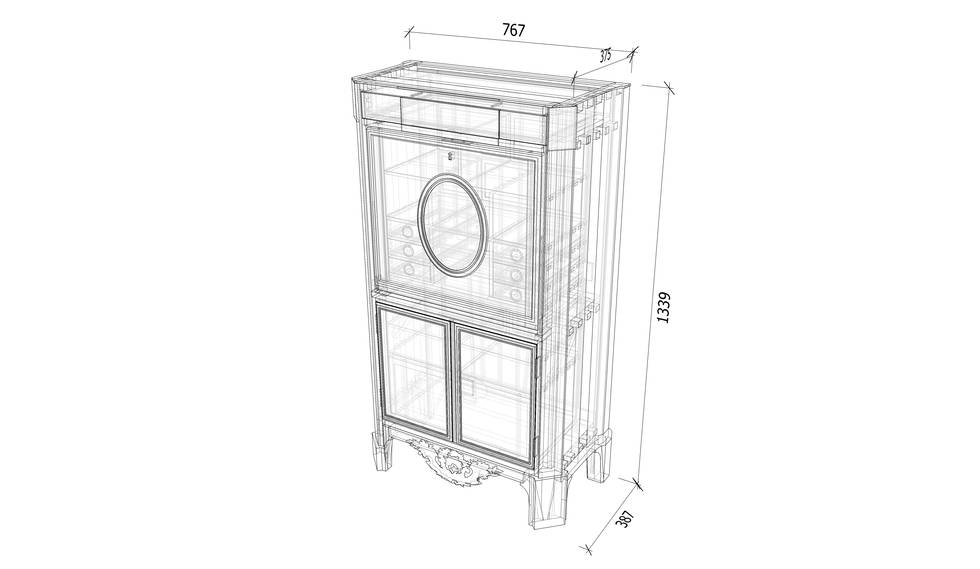Date: 1783
Maker: Cabinetwork by Jean-Henri Riesener; altered by the addition of the gilt-bronze medallion and rectangular plaque, about 1794–1825
Materials: Oak, purplewood, satiné, tulipwood, stained woods, burr wood, ebony or ebonised wood, box, gilt bronze, Carrara marble
Measurements: 139.6 x 80.5 x 42 cm
Inv. no. F302
The Petit Trianon was given by Louis XVI to his young wife, Marie-Antoinette, as a private retreat away from the rigours of court etiquette. It was to be her own domain, encompassing a stunning neoclassical building completed only a decade earlier, and several acres of parkland where she was able to indulge her love of gardens, theatre, and the pastoral life. Unlike the furnishing of Versailles, here she employed her own furniture administration and was personally involved in all aspects of the interior.
In 1776 she had some of the rooms renovated, particularly her boudoir, which had connecting doors to her bedroom and to the salon, or main reception room. The engineer Jean-Gotfritt Mercklein (1733–1808) fitted two adjustable wall-panels in the boudoir, which could be raised or lowered to reveal the windows and allow direct access to the gardens outside. This theme of bringing nature inside was continued in the following decade when new furniture was delivered, including this desk and, in 1787, a set of seat furniture by Georges Jacob (1739–1814) for the queen’s bedroom next door.
The gilded mounts of the desk would have been in complete harmony with the décor. They stand out for the quality of their execution and the naturalistic detail: delicate floral sprays of roses, pinks and convolvulus held together by ribbons frame the medallion, and a beautifully modelled frieze of acanthus and ears of grain, looped through flower heads and tied by ribbons, runs along the cornice.
At the bottom of the desk, two horns of plenty are overflowing with more flowers and fruits, as well as coins and medals and, playfully, a crown. The mounts were used by Riesener on other furniture for Marie-Antoinette, such as the chest-of-drawers delivered to Marly in 1782.
The marquetry decoration is similarly characteristic of furniture he made for the queen, with the trellis pattern enclosing flower heads.
Originally, this would have been much more vividly coloured, but over time light has damaged the colours: the background to the mounts on the canted corners and the frieze is now a green colour, which might mean that initially it was blue (as blue fades to green), and the trellis would have been a stronger purple-red against a yellow background inlaid with green (or blue) flowers.
The full impact of Riesener’s design has been lost, however, because the gilt-bronze medallion in the centre of the desk is a later addition. It is most likely that in its place was a marquetry plaque of a pastoral theme, which would have harmonised more fully with the interior.
Additionally, the rectangular plaque in the centre of the frieze, with its depiction of the infant Mercury, the messenger of the gods, and his companions, has been added later. Perhaps it replaced Marie-Antoinette’s initials, which Riesener used several times as a charming decorative conceit.
The gilt-bronze medallion, depicting a small child being offered to the altar of Cupid (The Sacrifice to Love), is also found on another desk by Riesener, which can be seen here.
The desk was designed to go against a wall. The top marquetry panel opens downwards to reveal the inner cabinet with its shelves and drawers, some of them secret. Marie-Antoinette was virtually never left alone, and so this kind of closable, lockable space must have been appreciated by her.
Underneath, there are four more shelves and a single strong box, with another key for valuables. The interior of the desk has been just as beautifully finished as the exterior, with carefully chosen veneers of tulipwood, banded with stringing of box and ebonised wood, and surrounded with a deeper-coloured purplewood.
When the fall-front is open it forms a leather-covered writing surface, its weight supported by a counterweight mechanism hidden inside.
This model of desk must have appealed not only because of its convenient functionality (one small drawer was even equipped with silvered pots for the ink and sand used for writing), but because it closed up into a relatively compact piece that would have taken up minimal space in a small room. It also provided a large decorative surface on which Riesener’s celebrated marquetry was displayed and would have made a powerful and colourful impact as part of the interior décor.
There are two marks on the back of the desk, which allow us to be specific about its intended location. Painted in black ink are the initials C.T. with a crown above, the mark used to denote furniture belonging to the Petit Trianon. There is also the mark of the queen’s own furniture administration, stamped into the wood: Garde-Meuble de la Reine.
For more information: Jacobsen, H. et al., Jean-Henri Riesener. Cabinetmaker to Louis XVI and Marie-Antoinette. Furniture in the Wallace Collection, Royal Collection and Waddesdon Manor, London, 2020, no. 25.
